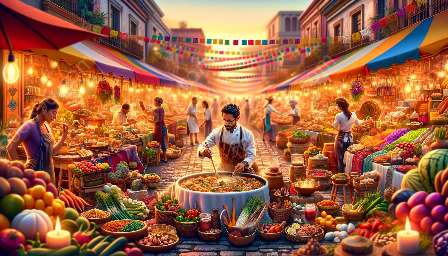Latin American cuisine is a melting pot of flavors and culinary traditions. Historically, the foundations of Latin American cuisine were influenced by the diverse food practices of pre-Columbian societies. The indigenous cultures across the region, including the Aztecs, Mayans, and Incas, developed an intricate culinary landscape that continues to shape the vibrant food culture of Latin America today. Exploring pre-Columbian cuisine in Latin America provides a rich understanding of the historical, cultural, and gastronomic aspects that have contributed to the tapestry of Latin American cuisine.
Exploring Pre-Columbian Culinary Heritage
The pre-Columbian era in Latin America spans thousands of years and is characterized by the development of sophisticated agricultural practices, unique cooking techniques, and a rich assortment of native ingredients. These ancient civilizations cultivated a diverse array of crops such as maize, beans, squash, potatoes, quinoa, and chilies, which formed the cornerstone of their culinary traditions. The cultivation of these crops was key to the survival and culinary innovation of the pre-Columbian societies in Latin America.
Ingredients: Maize, or corn, held a central position in pre-Columbian cuisine. It was not only a staple food but also held significant cultural and spiritual importance. Various types of maize were cultivated and used to prepare a wide range of dishes, including tamales, tortillas, and pozole. Beans and squash were also prevalent in pre-Columbian kitchens and were often combined with maize to create hearty and nutritious meals. The introduction of chili peppers, tomatoes, and cocoa by the Mayans significantly enriched the flavor profiles of pre-Columbian cuisine and laid the foundation for the robust and spicy flavors that are characteristic of Latin American dishes.
Cooking Techniques: Pre-Columbian societies employed a variety of cooking methods, such as grilling, steaming, and boiling. The use of traditional tools like comals (flat griddles) for tortilla-making and metates (grinding stones) for preparing ingredients showcased the resourcefulness and culinary ingenuity of these ancient cultures. Additionally, the practice of nixtamalization, a process of treating maize with an alkaline solution, not only enhanced the nutritional value of maize but also revolutionized the preparation of masa, the dough used for making tortillas and other maize-based delicacies.
Cultural Significance of Pre-Columbian Cuisine
Pre-Columbian cuisine in Latin America was intricately intertwined with cultural rituals, beliefs, and social structures. Food played a central role in religious ceremonies, feasts, and daily life, reflecting a deep connection between culinary practices and spiritual beliefs. The Mayans, for instance, held corn in high esteem and incorporated it into creation myths, thus elevating its significance beyond mere sustenance. The communal act of preparing and sharing meals fostered social cohesion and served as a means of expressing cultural identity, solidarity, and hospitality within pre-Columbian societies.
Legacy in Latin American Cuisine: The enduring legacy of pre-Columbian cuisine is palpable in contemporary Latin American culinary traditions. Many iconic dishes, such as tamales, ceviche, and mole, can be traced back to the culinary heritage of pre-Columbian societies. The blending of indigenous ingredients, culinary techniques, and flavors with influences from Spanish, African, and other immigrant culinary traditions during the colonial period has given rise to the diverse and dynamic gastronomy that defines Latin American cuisine today.
The Impact on Latin American Cuisine History
The exploration of pre-Columbian cuisine in Latin America provides invaluable insights into the historical evolution of Latin American cuisine. It elucidates the complex interplay between indigenous foodways, European influences, and African contributions, resulting in a mosaic of flavors, textures, and aromas that are emblematic of the region's culinary prowess. Understanding the deep-rooted connection between pre-Columbian culinary practices and the subsequent culinary developments in Latin America sheds light on the resilience and adaptability of food cultures in the face of historical transformations and globalization.
Conclusion
Pre-Columbian cuisine in Latin America is a testament to the ingenuity, resourcefulness, and cultural richness of the indigenous societies that laid the groundwork for Latin American culinary excellence. Exploring the ingredients, cooking techniques, and cultural significance of pre-Columbian cuisine provides a profound appreciation for the profound influence of ancient traditions on the vibrant and diverse tapestry of Latin American cuisine. The continuity of pre-Columbian culinary legacies in modern Latin American gastronomy exemplifies the enduring spirit of innovation and adaptation that defines the region's culinary identity.

